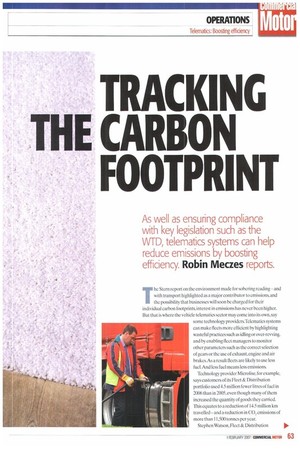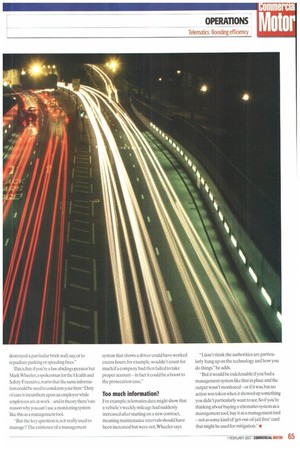TRACKING THECARBON FOOTPRINT
Page 63

Page 64

Page 65

If you've noticed an error in this article please click here to report it so we can fix it.
As well as ensuring compliance with key legislation such as the WM, telematics systems can help reduce emissions by boosting
efficiency. Robin Meczes reports.
The Stern report on the environment made for sobering reading —and with transport highlighted as a major contributor to emissions, and the possibility that businesses will soon be charged for their individual carbon footprints, interest in emissions has never been higher. But that is where the vehicle telematics sector may come into its own, say some technology providers.Telematics systems can make fleets more efficient by highlighting wasteful practices such as idling or over-revving, and by enabling fleet managers to monitor other parameters such as the correct selection of gears or the use of exhaust, engine and air brakes.As a result fleets are likely to use less fuel. And less fuel means less emissions.
Technology provider Microlise, for example, says customers of its Fleet & Distribution portfolio used 4.5 million fewer litres of fuel in 2006 than in 2005, even though many of them increased the quantity of goods they carried. This equates to a reduction of 14.5 million km travelled — and a reduction in CO, emissions of more than 11,500 tonnes per year.
Stephen Watson, Fleet & Distribution product manager at Microlise, reports that very few customers buy into the technology to reduce their carbon emissions, even though it can do just that.
"It's not the main reason people buy into telematics systems,but if you use fewer vehicles and fewer drivers and are covering fewer miles, you'll reduce your fuel costs and servicing requirements and be environmentally responsible as well," he points out.
-That's something customers are now jumping on and promoting to their clients.
Real-time monitoring
Since telematics systems enable individual vehicle parameters to be monitored, the role of this technology could theoretically be extended. For example, an emissions sensor on board a vehicle could be used to record precise exhaust outputs from minute to minute and the telematics system could be used to send that data back to fleet managers in real time, alerting them immediately if a vehicle should start to run out of tune.
If the government introduced a scheme to charge motorists for their actual rather than theoretical vehicle emissions, a telematics system could also be used to send the necessary data to a central agency for the purposes of calculating the user's bill.This might sound far-fetched but Watson can foresee a time when live remote monitoring of emissions will be a routine occurrence.
"I think this would be provided by the vehicle manufacturer, via the engine management system, rather than by an additional sensor on the exhaust," he says.-Once the information is on the CAN-bus, however, there's no reason why it couldn't be picked up by a telematics system."
Such a development would almost certainly need to be driven by new legislation hut it's highly likely sooner or later, he adds:1'd he surprised if they didn't look at this at some point as a kind of 'pay-as-you-pollute' approach.
As the Treasury has already considered using telematics technology to charge motorists on a pay-as-you-go basis for road usage, the idea of pay-as-you-pollute certainly isn't out of the question.
A Treasury spokesman explains: "There is no plan to introduce something like this at the moment to make such a change would radically alter the way tax on vehicles is currently charged.That said, all taxes are kept under review, so we would never entirely reject a proposal."
Legislation also lies behind the duty of care issue, and this is generally believed to be about to ignite the vehicle telematics market. After all, telematics systems can be used to help managers measure and monitor compliance with key legislation such as the Working Time Directive and, when it finally emerges, the corporate manslaughter law "It's about managing risk more effectively and taking the issues seriously" according to John Wisdom, sales director of Cybit. "Telematics provides visibility over drivers and vehicles so you can assess what's going on and then do something about it if necessary."
First and foremost,says Wisdom, telematics gives fleet managers the ability to oversee the running of an operation in real time with all the stops and starts and individual activities.-You're then in a position to challenge or investigate what's really going on," he points out.
Wisdom adds that modern telematics systems can also be used in conjunction with PIN-code entry systems or smart cards to: • Ensure only the right people get behind the wheel of a vehicle • Confirm when a driver has carried out his daily vehicle inspections • Monitor compliance with the working time rules.
And with the right back-office software, telematics systems also have a big role to play in monitoring vehicle maintenance histories or driver licence checkswhich could be crucial in proving due diligence after an accident.
Check speed limiters
Monitoring vehicle speeds is another capability that could be useful, Wisdom suggests:"If you're monitoring speeds you can see immediately if a speed limiter isn't working properly, for example. You can also use the system to quickly rank your drivers in terms of performance and sec who has a propensity to speed and who hasn't. At that point you're well placed to take action to mitigate that risk."
Such information could be important if a firm were to find itself in court. While CM doesn't know of any cases in which telematics data has led to a firm being cleared of blame "Information is power and if you can show you're proactively doing something to mitigate the risks, check situations you might be uncomfortable with and ensure compliance, I believe this would be taken into consideration," he says.
"I'm aware of lots of instances when information like this has been used to counter other claims of various sorts, such as an accusation that one of your vehicles has destroyed a particular brick wall, say,or to repudiate parking or speeding fines."
This is fine if you're a law abiding operator but Mark Wheeler, a spokesman for the Health and Safety Executive,wams that the same information could be used to condemn your firm:-Duty of care is incumbent upon an employer while employees are at work and in theory there's no reason why you can't use a monitoring system like this as a management tool.
"But the key question is, is it really used to manage? The existence of a management system that shows a driver could have worked excess hours, for example, wouldn't count for much if a company had then failed to take proper account-in fact it could be a boost to the prosecution ease."
Too much information?
For example, telematics data might show that a vehicle's weekly mileage had suddenly increased after starting on a new contract, meaning maintenance intervals should have been increased but were not,Wheeler says. "I don't think the authorities are particularly hung up on the technology and how you do things," he adds.
"But it would be indefensible if you had a management system like that in place and the output wasn't monitored or if it was, but no action was taken when it showed up something you didn't particularly want to see. So if you're thinking about buying a telematics system as a management tool, buy it as a management tool -not as some kind of `get-out-of-jail-free' card that might be used for mitigation.".


























































































































































































